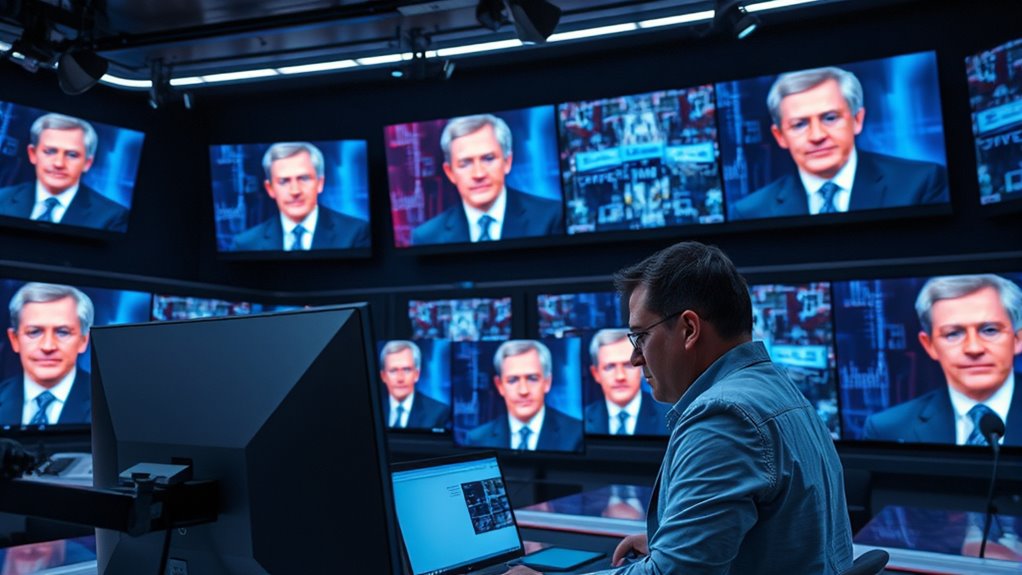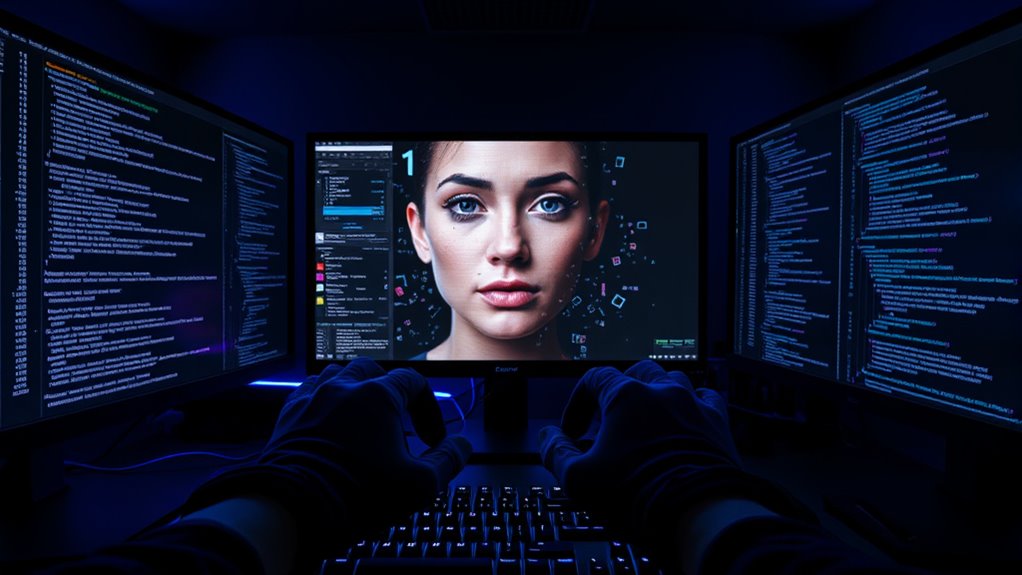In today’s era of increasingly realistic deepfakes, safeguarding your image starts with awareness. Learn to spot signs like facial inconsistencies or mismatched audio, and verify videos through trusted sources. Using digital watermarks and detection tools adds extra protection, while supporting transparency from content creators helps maintain trust. Staying informed about advances in tech and fostering responsible use are key. Keep exploring to discover more effective ways to protect yourself from malicious synthetic media.
Key Takeaways
- Use digital watermarks and AI detection tools to verify the authenticity of videos and prevent misinformation.
- Stay vigilant for facial inconsistencies, unnatural movements, or mismatched audio in suspicious videos.
- Promote transparency by encouraging content creators to disclose synthetic or manipulated media.
- Educate yourself and others about deepfake risks, ethical implications, and ways to recognize manipulated content.
- Support responsible AI use and platform safeguards to reduce the spread of harmful deepfake scandals.

Artificial intelligence has made it easier than ever to create convincing deepfake videos, but this technological breakthrough also brings significant risks. As these manipulated media become more realistic, you need to be aware of the ethical implications surrounding their use. Deepfakes can easily be employed to spread misinformation, damage reputations, or manipulate public opinion, making it essential to understand how to identify and protect yourself from malicious content. On the other hand, developers and policymakers are working to implement technological safeguards—such as digital watermarks and AI detection tools—that aim to distinguish genuine videos from synthetic ones. These safeguards are critical in maintaining trust and ensuring that technology serves to inform rather than deceive. Understanding the signs of a checked-out partner can also help you stay alert to potential manipulation or deception in digital interactions.
Deepfakes pose significant risks but are countered by technological safeguards like watermarks and detection tools to protect trust and authenticity.
You might wonder how to stay safe amid this landscape of evolving threats. Recognizing deepfakes isn’t always straightforward, especially as creators improve their techniques. You should stay vigilant by scrutinizing videos, especially those with sensational claims or emotional triggers. Look for inconsistencies in facial expressions, unnatural blinking, or mismatched audio and visual cues. Relying on trusted sources and verifying content through multiple outlets can also help mitigate the risk of falling prey to false information. Educating yourself about the ethical implications of deepfake technology isn’t just about avoiding scams; it’s about understanding the broader impact on society and your personal reputation.
The conversation around technological safeguards is ongoing, and it’s important that you support initiatives that promote responsible use of AI. For example, some platforms now incorporate AI-based detection systems that flag manipulated content before it spreads widely. These safeguards are essential tools in curbing the malicious use of deepfakes. As a user, you should advocate for transparency from content creators and platforms, requesting clear disclosures when videos are altered or synthetic. This proactive stance helps foster an environment where the benefits of AI can be enjoyed without compromising integrity or safety.
Ultimately, safeguarding your image in this era of synthetic media requires a combination of awareness, critical thinking, and support for technological safeguards. While AI has opened new frontiers for creativity and innovation, it also necessitates responsible handling and regulation. By understanding the ethical implications and staying informed about advances in detection technology, you can better navigate the risks posed by deepfakes. Remember, the power to protect yourself and promote a trustworthy digital environment lies in your willingness to stay educated and cautious.
Frequently Asked Questions
How Can Individuals Detect Deepfake Videos Effectively?
To detect deepfake videos effectively, you should look for visual anomalies like unnatural blinking or distorted facial features. Pay attention to audio inconsistencies such as mismatched voice tone or strange pauses. Use specialized tools or apps that analyze videos for signs of manipulation. Your keen eye combined with these techniques helps you spot deepfakes quickly, protecting your credibility and ensuring you share authentic content.
What Legal Actions Exist Against Deepfake Creators?
Imagine the threat lurking behind every deepfake—legal repercussions that could ruin your reputation. Authorities are cracking down, with laws designed to punish deepfake creators for fraud, defamation, and intellectual property theft. You can pursue civil lawsuits for damages or criminal charges if you’re harmed. While regulations evolve, staying informed about your rights helps you protect your image in this complex digital landscape. The fight against malicious deepfakes is just beginning.
How Do Deepfakes Impact Mental Health and Reputation?
Deepfakes can seriously impact your mental health and reputation by causing emotional trauma from false portrayals. They erode social trust, making it hard for you to believe or be believed by others. You might feel anxious, betrayed, or isolated as your image is manipulated without consent. Protecting yourself requires awareness and proactive steps to verify information, ensuring your reputation remains intact and your mental well-being isn’t compromised by malicious synthetic media.
Are There Ethical Guidelines for Developing AI Deepfake Technology?
Imagine a compass guiding your journey—ethical frameworks act like that in AI deepfake development. You, as a developer, carry responsibilities to follow these guidelines, ensuring your creations respect truth and privacy. While formal ethical standards are emerging, your commitment to honesty and harm reduction is essential. By adhering to these principles, you help build trust and protect individuals from misuse, steering the future of AI towards integrity and social good.
What Future Trends Are Expected in Deepfake Detection?
Future trends in deepfake detection focus on enhancing biometric authentication and media literacy. You’ll see more sophisticated algorithms that analyze facial movements, voice patterns, and biometric data to identify fakes. Educational campaigns will also help you develop critical media literacy skills, enabling you to spot deepfakes easily. These combined efforts aim to stay ahead of increasingly realistic synthetic media, protecting your identity and ensuring you trust what you see online.
Conclusion
While deepfake scandals can seem overwhelming, remember that staying informed and cautious is your best defense. You might think it’s impossible to spot fake images or videos, but with practice and the right tools, you can protect your reputation. Don’t let fear hold you back—by being vigilant and skeptical of suspicious content, you can navigate the synthetic media era safely. Your awareness and proactive approach are your strongest shields against deception.









